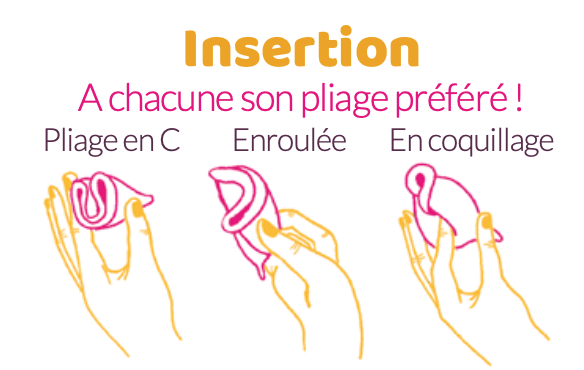The menstrual cup, also simply called « cup », is one of the most known natural and alternative feminine protections. But what are its exact advantages, compared to the single-use tampons? Well, there are a lot of advantages, to be sincere… Let's have a look together.
First of all, the cup is an internal protection made from silicone, rubber or latex that has the form of a little funnel. It could be described as a little operculum (in other words, a little lid) that retains and collects the menstrual blood. The cup has to be put in like a common tampon, with the only difference that is has to be fold first, in order to make it fit well. And once you put it in, you simply have to let it go, and the cup will then softly swell like a balloon, in order to make sure it will firmly stay in place. And for the sake of clarity: the cup keeps in place thanks to the support of the vaginal muscles, and not because of a supposed awkward suction effect, like a lot of people tend to believe..

Instructions for use of the brand LAMAZUNA
Which size should I choose?
Every menstrual cup has a little rod that makes it easier for you to take it out. And as this little rod is quite long, we would recommend you to shorten it, which you can do very easily, in order to prevent it from becoming uncomfortable when you have put it in. It really would be a pitty to suffer from such an avoidable detail, as for the rest menstrual cups are remarkably practical!
And this little rod isn't the only thing you can adapt to your size, as several brands offer two different sizes of menstrual cups. The size 1 or B is intended for women younger than 30 years who have never given birth through a 'normal' vaginal delivery, while the size 2 or A is rather intended for women who already have given birth in this way, as well as for women who are older than 30. Nevertheless, there is no such thing as a universally applicable system, as there also are brands that use the S, M and L size marking. And in the latter case, we rather advise you to take into account your blood loss, in order to choose that one cup that is most suitable for you.
It is said you can wear the cup up to 12 hours, but we would rather recommend you to wear it 8 hours at most. You have to keep in mind that the risk of a toxic shock is always present, given the fact that the blood stagnates in the cup - nevertheless, according to the specialists it is very rare if you observe the logical hygienical prescriptions (wash your hands before and after you refresh your cup, wash the cup after use, empty it regularly, etc...). So in this regard you always have to stay alert, just like when you use a tampon. And regarding to the readers amongst you who use an IUD (or coil): the menstrual cup is perfectly combinable with the latter, without any risk of embarrassment or disturbance. No worries !
If you want to take out the cup, you simply have to push on it in order to make the little rod point out, and grab it. Next, you simply have to pull, or pinch the extremity of the cup, or you can also put your finger between the vaginal wall and the cup to create an air suction in order to take the cup out easily.
What are the advantages and inconveniences of this little cup?
The menstrual cup is so little and discreet that you can easily take it with you wherever you go. Usually there also is a little storage bag included in the purchase price. Obviously, the cup is reusable, and you can keep it for at least 5 years. Doing so, you will prevent thousands of tampons and sanitary napkins.
Unlike other alternative feminine protections, the menstrual cup is relatively cheap and it quickly has a positive impact on your budget as you only have to buy one to begin with, and you can keep on using it for a long time afterwards.
Another advantage - because, yes, indeed, we are not done yet - is that the cup allows a physical activity without any risk of a highly undesirable leakage. Nevertheless, I of course cannot guarantuee you that you will be perfectly protected if you repeatedly jump into a pool or into the sea.. In that case, your protection will more precisely depend on you blood loss, the holding capacity of your cup, and the time you spend in the water. In short: in this very case every woman has to rely on her own experience and opinion about this question.
Unfortunately, every good thing also has disadvantages, as the "ultimum remedium" or the perfect solution hasn't been found (yet). In this regard, for example, the cup has no applicator, so you have to put it in yourself. And some women find this rather uncomfortable, as they don't like direct contact with blood. Other women don't like to see blood, and could be embarrassed at the very sight of the pure and liquid blood contained by the cup..
Because all good things have an end..
Here ends our introduction to the menstrual cup. Once more, we tried to inform you in a clear and practical way, in order to help you to make your next decision in full knowledge of the facts. And maybe - who knows - it will allow you to take the leap, and make you choose for a more eco-friendly alternative. Because you always have to keep in mind that an ecological lifestyle depends on our most common habits and gestures.. However, personally I find the menstrual cup less bothersome than the 'classic' hygienical protections. But from now on, of course, it's completely up to you: form your own opinion, and don't hesitate to share your feedback with us on the subject. As it isn't an absolute question at all, every personal experience helps to better inform the others.
Up to this day, the menstrual cup has helped numerous women to come through their 'time of the month' in a comfortable and carefree way. Will you be the next one to join them?
Whatever your decision may be, we will surely see each other soon for a new bouncy adventure …

Loulou the kangaroo
